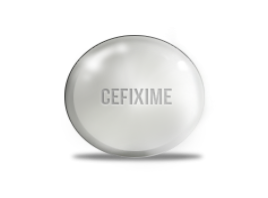Buy Cefixime Online

Cefixime use in the treatment of infectious diseases that are caused by the microflora sensitive to Cefixime. The drug is used in the treatment of inflammatory and infectious diseases.
Cefixime: composition, indications, dosage, side effects
The active component of the drug is cefixime. Available in tablet form 100 mg and 200mg.
Indications
The drug is indicated for use in the treatment of infectious diseases that are caused by the microflora sensitive to Cefixime. The drug is used in the treatment of inflammatory and infectious diseases of the respiratory system, such as chronic and acute bronchitis, pleurisy and pneumonia. The drug is used for inflammatory lesions of the bile ducts (cholangitis and cholecystitis), diseases of the genitourinary system (endometritis, prostatitis, cystitis and pyelonephritis), ENT diseases (pharyngitis, otitis media, sinusitis and tonsillitis), in the treatment of scarlet fever, cystic fibrosis, gonorrhea, intestinal infections in children and infectious and inflammatory lesions of bones, soft tissues and skin.
Cefixime is an antibiotic-cephalosporin (third generation). Its bactericidal activity (the ability to kill bacteria) is due to the inhibition of the production of components of cell membranes. It is active against most Gram (+) and Gram (-) microorganisms. This drug is characterized by high resistance to penicillinases, cephalosporinases (?- lactamase) of bacteria. Active against the following microorganisms: Streptococcus pneumoniae, Streptococcus pyogenes, Haemophilus influenzae, Moraxella catarrhalis, Escherichia coli, Proteus mirabilis, Neisseria gonorrhoeae, Streptococcus agalactiae, Haemophilus parainfluenzae, Proteus vulgaris, Klebsiella pneumoniae, Klebsiella oxytoca, Pasteurella multocida, Providencia spp., Salmonella spp., Shigella spp., Citrobacter amalonaticus, Citrobacter diversus.
Enterococcus spp., Listeria monocytogenes, Pseudomonas spp., most strains of Enterobacter spp., Staphylococcus spp., Bacteroides fragilis, Clostridium spp.are resistant to the drug.
Cefixime is prescribed for infections caused by microorganisms that are sensitive to it:
- Streptococcal tonsillitis, pharyngitis;
- With sinusitis;
- In acute bronchitis;
- For acute otitis media;
- For uncomplicated gonorrhea;
- With exacerbation of chronic bronchitis;
- For uncomplicated urinary tract infections;
- With shigellosis.
Contraindications
Hypersensitivity to beta-lactam antibiotics, individual intolerance to Cefixime, neonatal period.
Caution is recommended when prescribing the drug to children under 6 months of age, as well as to patients suffering from bronchial asthma, electrolyte imbalance, severe liver damage and malabsorption syndrome.
You can not use Cefixime:
- In case of allergy to cefixime, intolerance to auxiliary components;
- When allergic to cephalosporins, penicillins;
- Children with chronic renal failure;
- Children with a body weight of less than 25 kg.
With caution, it is used for kidney failure, colitis (in the past), in the elderly, and pregnant women.
Use during pregnancy and lactation
The use is allowed only when prescribed by a doctor, when the intended benefit to the mother exceeds the risk to the fetus. If necessary, use during lactation, feeding should be discontinued.
Method of administration and dosage
It is applied internally. The tablet should be swallowed whole, washed down with a sufficient amount of water, or crushed and diluted in water, drink the resulting suspension immediately after cooking. The medicine is taken regardless of the meal.
When using the drug in pediatrics, children under 12 years of age receive the drug orally at 8 mg per kg of body weight per day or 4 mg per kg of body weight every 12 hours.
Adult patients take the drug, regardless of food intake, 200 mg twice a day, in the treatment of uncomplicated forms of gonorrhea, patients receive the drug once for 400 mg.
Dosage for adults, children weighing more than 50 kg – 400 mg / day in one or two doses.
Dosage for children with a weight of 25-50 kg – mg/day in one single dose.
The duration of treatment depends on the course of the disease, the type of infection. After the symptoms of infection and fever disappear, it is advisable to continue taking the medication for at least 2-3 more days.
Overdose
When taken at a dose exceeding the maximum daily dose, side effects may increase.
Treatment of overdose: gastric lavage, symptomatic and supportive therapy. Hemodialysis, peritoneal dialysis are not effective.
Side effects
From the blood system, hematopoietic organs: leukopenia, thrombocytopenia, agranulocytosis, pancytopenia, eosinophilia, blood clotting disorders.
From the genitourinary system: increased creatinine concentration in the blood, hematuria.
Allergic reactions: urticaria, pruritus, Lyell's syndrome, drug fever, hemolytic anemia, interstitial nephritis, serum sickness-like syndrome, anaphylactic shock.
Reactions from the digestive system: abdominal pain, diarrhea, digestive disorders, nausea, pseudomembranous colitis.
From the nervous system: headaches, dizziness, dysphoria.
From the side of the hepatobiliary system: increased levels of alkaline phosphatase, transaminases, hepatitis, cholestatic jaundice.
Storage conditions and terms
At 15-25°C. The shelf life is three years.
